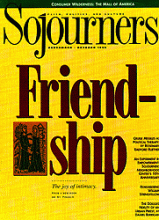The new fall television season is upon us. And with it for the first time comes the advent of network warning "labels" on violent entertainment programming. These warnings will be carried before a violent show, during commercial breaks, and be part of the advance promotional advertising for a show. The program warnings institute on the airwaves a system akin to the movie industry's ratings code and record industry's "explicit lyrics" sticker.
This "voluntary" initiative from the broadcast industry came as the result of the "Simon Act" passed in 1988 and named for its author and chief sponsor, Sen. Paul Simon (D-Ill.). That's the guy with the bow tie who tried to run for president calling himself a New Deal liberal, not Paul Simon the fifty-something singer-songwriter who's married to that fresh and talented young Edie Brickell.
The Simon Act gave the Big Three TV networks, and Fox, a five-year exemption from federal anti-trust statutes so that they could get together and conspire to restrain the on-screen trade in decapitations, severed limbs, and other atrocities. As the senator's press releases tell it, the story of the Simon Act, and the resulting program warnings, began one dark and stormy night when the traveling senator checked into a hotel room, loosened his bow tie, and flipped on the tube for the news, only to behold a film of a man being cut in half by a chain saw. Simon came back to Washington and told his staff to get cracking.
Since the law was passed, Simon has held a series of oversight hearings to hold the network's feet to the fire on the question of TV violence. This year's round of hearings, part of which came during the exceptionally bloody and depraved programming of the May TV ratings "sweeps" period, garnered enormous publicity, all of it negative for the networks. Now they are running for cover.
Read the Full Article

